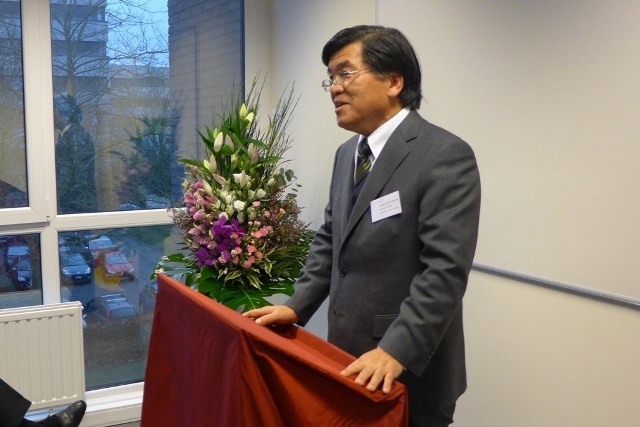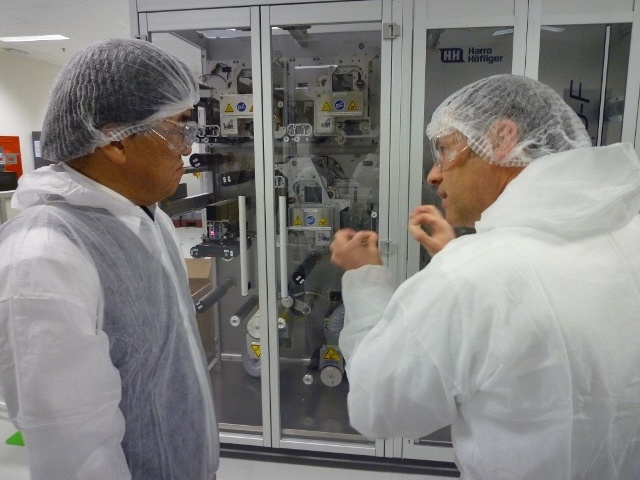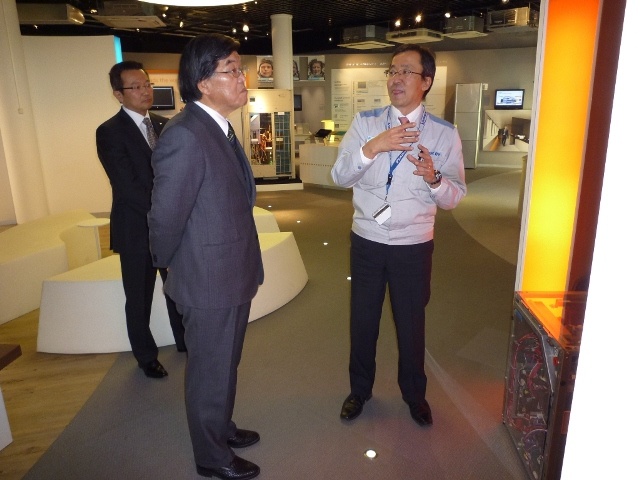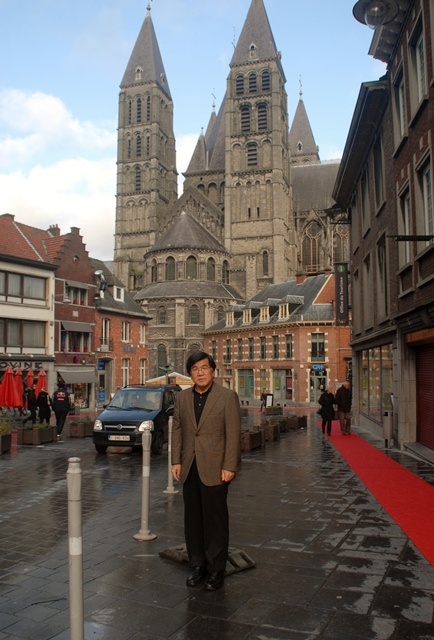A Series of Company Visits starts (No.4)
I read an article on crime statistics for the first half of 2012 in the local newspaper the other day. According to the article, the total number of crimes in Belgium during these 6 months amounted to 524 thousands cases, which was a decrease by about 31 thousands or 5,6% compared to the same period last year (555 thousands cases). This figure does not quite correspond to what we experience in our daily lives as residents in Belgium. What has decreased are primarily violent crimes such as murder and armed robbery, illicit trafficking in weapons and drug-related offenses, the type of crimes that do not concern our daily lives. The number of crimes that are closer to one’s own life, such as theft (stealing), extortion, fraud posing as a policeman or mailman and unauthorized access to bank cards, has instead increased by nearly 40 %. In particular, the number of sneak theft cases, a frequent topic among Japanese residents, amounted to 36.507 (76 per 10.000 residences), which is an increase of 10.8 % compared to the same period last year. It is an increase of 31,8% compared to 5 years ago. It is reported in the same article that these crimes are committed by professional thieves from Eastern Europe moving around in groups across various areas where they burgle houses with the main aim to steal jewellery and other valuables. On the other hand, the number of car thefts and car break-ins has decreased by more than 10 %. While this is a good news, it is difficult to wipe away the everyday insecurity because the newspaper says that the situation in major cities such as Brussels is getting worse. By the way, according to statistics from the Japanese Ministry of Justice, the number of crimes during half a year in 2010 amounted to 793 thousands cases, so if we compare the Belgian and Japanese figures, the Belgian crime rate is about 8 times as high as that of Japan taking into account its population. Hmm, it is a serious situation indeed.
<Opening of the AWEX Japan Welcome Office in Louvain-la-Neuve>
 I visited Louvain-la-Neuve, located about 30 km southeast of Brussels, and attended the opening ceremony of the Japan Welcome Office of AWEX (The Wallonia Foreign Trade and Investment Agency) as one of the guests. Though it was a modest ceremony, it was an enjoyable event in a family atmosphere, attended by the director of the Science Park where the Japan Office is located and by the local academics as well. One full time worker at the Japanese Office is a Belgian woman named Ms Maes Mio. She received a scholarship of the Ministry of Education, Culture, Sports and Science and studied at Tohoku University in Japan for two years. Her mother being Japanese, she was very fluent in Japanese. In order to attract investments of foreign companies in Wallonia (French-speaking region), AWEX already opened offices in charge of China, India, Latin America and Europe respectively. The Japan office is the fifth one. There are also plans to open offices in charge of North America and ASEAN next year. I visited Louvain-la-Neuve, located about 30 km southeast of Brussels, and attended the opening ceremony of the Japan Welcome Office of AWEX (The Wallonia Foreign Trade and Investment Agency) as one of the guests. Though it was a modest ceremony, it was an enjoyable event in a family atmosphere, attended by the director of the Science Park where the Japan Office is located and by the local academics as well. One full time worker at the Japanese Office is a Belgian woman named Ms Maes Mio. She received a scholarship of the Ministry of Education, Culture, Sports and Science and studied at Tohoku University in Japan for two years. Her mother being Japanese, she was very fluent in Japanese. In order to attract investments of foreign companies in Wallonia (French-speaking region), AWEX already opened offices in charge of China, India, Latin America and Europe respectively. The Japan office is the fifth one. There are also plans to open offices in charge of North America and ASEAN next year.
In my speech at the ceremony, I welcomed the opening of the Japan Welcome Office and I raised three points to keep in mind for its future operation. The Japanese Office needs a proactive approach, not a wait-and-see approach when it comes to management. The Japan Welcome Office should try to attract small and medium sized enterprises that have high technology and seek also cooperation with local universities and research institutions rather than expecting large-scale investments by big companies. They should not expect short-term results because Japanese companies tend to take their time to make the investment decisions. The Embassy of Japan is ready to support the Japan Welcome Office as much as possible to make it a success.
<Visit to two companies representative of Japan and Belgium>
 Last week I also visited a small town called “Beerse”, located about 60 km to the northeast of Brussels. The purpose was to visit Janssen Pharmaceutica, a Belgian representative pharmaceutical company. After I was welcomed by CEO Tom Heyman in the light rain, I followed a three-and-a-half hour full schedule with a briefing about the company, a visit to the factory and a luncheon meeting. One of the reasons I visited this company was the promise I made to Janssen Japan President Mr. Toon Overstijns when I visited the Japanese head office in Nishi-Kanda in Tokyo last September before leaving to Belgium (Mr. Overstijns also left Japan later that month to assume a new post at Beerse Headquarters). This pharmaceutical company was founded in 1953 by Dr. Paul Janssen (he passed away in 2003) at the age of 27 and has grown into a major corporation with more than 4000 employees in Belgium alone. The company also has a close relationship with Japan: pharmaceutical products worth a lot of money are exported to Japan every year (by the way, 33% of Belgium’s exports to Japan are medical supplies). In 1978 the branch company was founded in Japan (at present, 2000 employees). Janssen Pharmaceutica is a pioneer in drug development in the field of cancer, immune diseases, central nervous system disorders and infectious diseases such as AIDS. Even today, more than 20 % of sales results are used for research and development in these fields. This tradition has been left behind by the founder Dr. Paul Janssen who dedicated his life to the development of new drugs (In Belgium, everybody knows him; he is a self‐made man so to speak). In the aging society of Japan, the demand for medicine is more and more growing, so I guess that the relationship between Japan and Janssen Pharmaceutica will become even deeper. Last week I also visited a small town called “Beerse”, located about 60 km to the northeast of Brussels. The purpose was to visit Janssen Pharmaceutica, a Belgian representative pharmaceutical company. After I was welcomed by CEO Tom Heyman in the light rain, I followed a three-and-a-half hour full schedule with a briefing about the company, a visit to the factory and a luncheon meeting. One of the reasons I visited this company was the promise I made to Janssen Japan President Mr. Toon Overstijns when I visited the Japanese head office in Nishi-Kanda in Tokyo last September before leaving to Belgium (Mr. Overstijns also left Japan later that month to assume a new post at Beerse Headquarters). This pharmaceutical company was founded in 1953 by Dr. Paul Janssen (he passed away in 2003) at the age of 27 and has grown into a major corporation with more than 4000 employees in Belgium alone. The company also has a close relationship with Japan: pharmaceutical products worth a lot of money are exported to Japan every year (by the way, 33% of Belgium’s exports to Japan are medical supplies). In 1978 the branch company was founded in Japan (at present, 2000 employees). Janssen Pharmaceutica is a pioneer in drug development in the field of cancer, immune diseases, central nervous system disorders and infectious diseases such as AIDS. Even today, more than 20 % of sales results are used for research and development in these fields. This tradition has been left behind by the founder Dr. Paul Janssen who dedicated his life to the development of new drugs (In Belgium, everybody knows him; he is a self‐made man so to speak). In the aging society of Japan, the demand for medicine is more and more growing, so I guess that the relationship between Japan and Janssen Pharmaceutica will become even deeper.
 One day after my visit to Janssen Pharmaceutica, I went to the port city of Oostende in the westernmost point of Belgium (120 km to the west of Brussels) to visit the factory of Daikin Europe, a major company in air conditioning. This company was founded 40 years ago in 1972, employs in total 5.281 employees (March 2012), among which 1.341 workers in the Oostende factory alone. Manufacturing and selling mainly household air conditioners and large air conditioners, the total sales last year amounted to a little less than 200 billion yen. Although the market share varies per country, it is about 20 % to 30%, which is a position to compete with the industry’s top companies. The reason for choosing Oostende as location for the factory was the proximity to the UK, which was a major market for air conditioners, the easy recruitment of skilled workers and English-speaking workers, and the investment incentives of the Province of West-Flanders. Daikin Europe is one of the biggest companies in Oostende, a town of 70.000 inhabitants. In 2010, a road was named after the headquarters’ president Mr. Noriyuki Inoue. Splendid! One day after my visit to Janssen Pharmaceutica, I went to the port city of Oostende in the westernmost point of Belgium (120 km to the west of Brussels) to visit the factory of Daikin Europe, a major company in air conditioning. This company was founded 40 years ago in 1972, employs in total 5.281 employees (March 2012), among which 1.341 workers in the Oostende factory alone. Manufacturing and selling mainly household air conditioners and large air conditioners, the total sales last year amounted to a little less than 200 billion yen. Although the market share varies per country, it is about 20 % to 30%, which is a position to compete with the industry’s top companies. The reason for choosing Oostende as location for the factory was the proximity to the UK, which was a major market for air conditioners, the easy recruitment of skilled workers and English-speaking workers, and the investment incentives of the Province of West-Flanders. Daikin Europe is one of the biggest companies in Oostende, a town of 70.000 inhabitants. In 2010, a road was named after the headquarters’ president Mr. Noriyuki Inoue. Splendid!
<UNESCO World Heritage Sites in Belgium>
 The other day I drove to Tournai, a town of 70.000 inhabitants, near the border with France, about 85km southwest of Brussels and visited the Notre Dame Cathedral, a UNESCO World Heritage Site. I was overwhelmed by such magnificence and by its massive spires which date back to the 12th century. The Cathedral is a mix of Romanesque and Gothic styles and you can see concurring extensions and reconstructions that took place over hundreds of years. I was moved from the bottom of my heart by the strength of the Catholic people’s religious passion for church architecture and its sustainability (the golden reliquary shrine and various monstrances in the Treasury are splendid and really worth seeing). The other day I drove to Tournai, a town of 70.000 inhabitants, near the border with France, about 85km southwest of Brussels and visited the Notre Dame Cathedral, a UNESCO World Heritage Site. I was overwhelmed by such magnificence and by its massive spires which date back to the 12th century. The Cathedral is a mix of Romanesque and Gothic styles and you can see concurring extensions and reconstructions that took place over hundreds of years. I was moved from the bottom of my heart by the strength of the Catholic people’s religious passion for church architecture and its sustainability (the golden reliquary shrine and various monstrances in the Treasury are splendid and really worth seeing).
By the way, there are 11 UNESCO World Heritage Sites in Belgium. The famous ones are the Grand Place in the centre of Brussels and the historic centre in Bruges (Brugge). What is interesting is that Flanders is dotted with medieval women’s age of convents called Beguinages, remembering part of the Belgian history that dates back to the Crusades. On the other hand, Japanese tourists never visit UNESCO World Heritage Sites such as “The Four Lifts on the Canal du Centre” and the “Neolithic Flint Mines at Spiennes”. These sites are appreciated by connoisseurs. In the field of modern architecture, buildings such as the “Major Town Houses of the Architect Victor Horta” and the “Stoclet House” (both in Brussels) are designated a UNESCO World Heritage Site, but few Japanese people know them. One of the characteristics of the Belgian World Heritage Sites is the fact that they are all cultural heritages. There are no natural heritages. Note that UNESCO’s World Heritage Convention entered into effect in 1972, so events to celebrate the 40th anniversary were held worldwide throughout this year. In Japan as well, a large-scale memorial symposium was held in November in Kyoto. At present, there are 964 Cultural and Natural Heritages which are designated by UNESCO a World Heritage Site and various problems about how to preserve and protect them have emerged. The system itself may have come to a big turning point.
<The Belgian Nobility>
The saying goes that if you throw a stone in Belgium, you will always hit a diplomat or a noble. It is natural that there are many diplomats in the international city of Brussels, but why are there so many nobles? This mystery was solved when I was invited the other day to a dinner hosted by a baron at his castle. According to the “information on the Belgian Nobility” that I obtained there, there are 1300 families with the title of nobility (20.000 individuals), among which only about 400 families inherited their title before the Belgian Independence in 1830. Many people became nobles during the era of the Duchy of Burgundy in the 14th and 15th century. In Belgium, the King’s right to grant titles of nobility is stipulated in the Constitution and even today people are made nobles every year. Individuals that have improved the reputation of the country in the field of politics and business or science, art and sports, and that have made a significant contribution to the development of society are granted the title of Count, Viscount or Baron. However, in the case of this new nobility, as a general rule, the titles are non-hereditary. This seems similar to the Japanese old decoration system such as the Order of the 1st and 2nd Class, but the difference is that there are no age criteria such as the “over 70 years old rule” in Japan. By the way, in recent years, an astronaut received the title of Viscount and a racing cyclist received the title of Baron. The “Nobility Office” of the Belgian Ministry of Foreign Affairs, which is in charge of the administrative affairs, issues the certificates to the “new nobility” and collects the registration fees. However, it is a mystery to me why the Ministry of Foreign Affairs is in charge of such business.
|